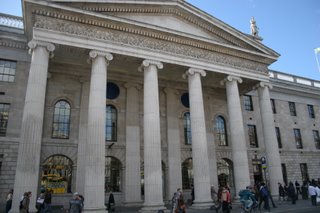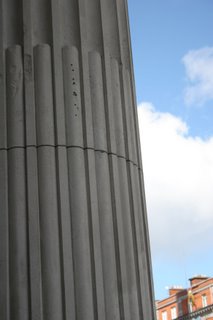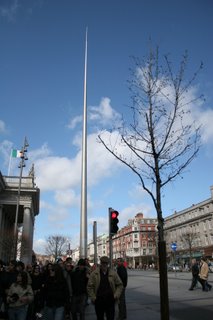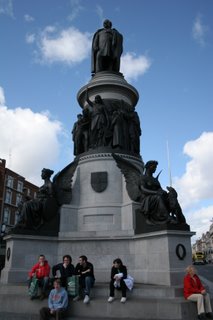than heading through it on a tour bus or in a car. You see and
experience so much more that way. Being that I don't have a
car and I get motion sick on the bus sometimes, that works for
me. (Of course, I take the bus to Dublin. Getting to it on foot would
would make for a long walk!) Since I've been walking the city, which
I thoroughly enjoy doing, I think I've started to fall in love with it.
Dublin is so many things all at once. Rough and polished. Old and
new. Wealthy and poor. Clean and dirty. Big and small. Busy and
slow. Surface and deep. Religious and not so religious. Historically
significant and ever present.
I went to Dublin this past Monday to grab lunch, to run an errand,
and for a chance to take a few photos that might serve as the
beginning of our walk together through Dublin. I hope you enjoy what
I have so far; This place is just too amazing not to share.
(And now for a disclaimer. I haven't gone on any official tours and I
don't have a team here at The Link Headquarters to edit and verify
all the information I randomly gather and overhear. Hopefully, I'll get
it all right.)
For a lesson in the countries history and a good movie, I recommend
you rent Michael Collins, starring Liam Neison. It's a good account of
what was happening in Ireland during the time period I'm about the
discuss. Let me know if you see it and what you think of it.
(Incidentally, Michael Collins uniform, gun, sword, and a few other
items are on display at the National Museum of Ireland. It was
expecially neat to see that after having watched the movie and
learning his story.)
The 12 pictures that follow are taken on O'Connell Street. It is
smack in the middle of City Center, and filled with the "ghosts
of Dublin", with it's historic public buildings and monuments.
O'Connell Street, a tree lined boulevard that is the widest in Ireland,
is named after Daniel O'Connor. (More on him in a minute.)

This is the General Post Office (GPO). This building, particularly significant in Irish
history, was the headquarters of the Irish Volunteers during the Easter Rising of
April 1916. While comparatively a small battle, it overshadowed much larger ones
before and after it. Easter Rising was a six day battle lead by Padraic Pearce
with James Connolly by his side, in the struggle against British rule. Pearce,
along with 150 men armed with ancient rifles and farm tools, took over the GPO.
It was on the steps of the GPO where Pearce "solemnly read out a stirring
document proclaiming the new Irish Republic" and their independence from Britain,
said the book Exploring Ireland.
During this battle, the GPO and much of Dublin's city was laid to ruins. By
the time Pearce surrendered on the sixth day, "over 400 people had died. Twice as
many police were killed as rebels, and four times as many civilians." In the aftermath
of battle, the British executed 14 of the Irish rebels, including Pearce and Connolly.
Ever since, they have remained heros in the classic republican tradition. Inside the
building is a pictorial account of the Rising and a small sculpture of Cu Chulainn,
the mythical symbol of Irish heroism.

Bullet holes from Easter Rising are still quite visible in
the columns in front of the GPO, maintained after it's
renovation.

This is the sign just inside the entrance of the GPO. It highlights the buildings
history...Note that it's written in English and in Gaelic.

Built in 1814 by Francis Johnson, this building is beautiful inside and out.
At the top of the GPO, "are three statues by John Smyth -
Fidelity, Hibernia (central) and Mercury," according www.irish-architecture.com.

Just across the street from the GPO is The Millenium Spire. It was built as
part of the countries millenium celebration in the spot previously occupied
by Nelson's Pillar. Nelson's Pillar was a monument that was blown up by
militant Republicans in 1966 on the 50th anniversary of the Easter Rising.
There are a couple interesting things I learned about Nelson's Pillar.
It was a common meeting place for Dubliners and offered the city's best viewing
platform. It was designed by Francis Johnson, the same person who designed the
GPO. No one was harmed when the monument crumbled to the street, except a
near by taxi. Dubliners called the remaining bottom of the monument 'The Stump'.
Two days after the original damage, engineers had determined the structure unsafe
and decided it must be brought down. "These experts' explosion caused more
destruction on O'Connell street than the original blast, breaking many windows and
causing painfully- amused Dubliners to roll their eyes," according to
www.absoluteastronomy.com.
Atop the pillar was a statue of Lord Horatio Nelson, a British Admiral. Seven
"students from the National College of Art and Design stole the statue's head on
St. Patrick's Day from a storage shed as a fund-raising prank to pay off a Student
Union's debt. They leased the head for £200 a month to an antiques dealer in
London for his shop window. It also appeared in a women's stocking commercial,
and on the stage of the Olympia Theatre with The Dubliners, an Irish folk band. The
students finally gave the head to the Lady Nelson about six months after taking it,
and it is now in the Civic Museum in Dublin," as stated in the above mentioned
website.
In October 2001, construction for the Millenium Spire began. In the ground (where
the Nelson Pillar had been) they found a time capsule that had been left there in
1808. When they opened it at the National Museum's conservation laboratoriess,
it was found to be empty except for a list of contents that should have been
enclosed in it!

Just another shot of it from a little further back. To give you a better idea of
where I'm standing/what you're seeing...I'm on the center part of O'Connell
Street. So, the lanes are to the right and left of me. The GPO is ahead and
to the left, just before the spire. Behind me is the monument you'll see after
the next picture.

The spire is 360 feet (or 120 meters) tall. It was made of stainless steel
tubes totaling 126 tons. In building it, the largest crane ever operated in
Ireland was used. It's construction was completed on January 21, 2003.

This is a statue of James Larkin (1876-1947). A trade union leader and social
activist, he was the founder of the Irish Transport and General Workers Union.
He also co-founded the Irish Labor Party (with James Connolly, who was executed
for his part of the Easter Rising in 1916). Larkin lead the Dublin Lockout of 1913,
the most severe industrial dispute in Ireland's history. Here he is, in full flow,
championing the workers' rights. His fundamental message appears on the plinth:
"The great appear great because we are on our knees. Let us arise." He later
immigrated to America.

This is a monument to Daniel O'Connell (1775-1847). He was a "politician,
lawyer and orator who secured Catholic emancipation for Ireland in 1829,
rallying support through enormous non-violent mass meetings. Sadly, his
peaceful methods were not successful in gaining Home Rule for the Irish,
but his achievements none the less earned him an eternal place in Dubliners'
hearts and in Dubin's main street, named after him," according to our
guidebook on Dublin.

This is just another picture of the O'Connell Monument. The lighting was a
little better this way, showing off more of the detail.

We're still continuing in the same direction on O'Connell Street. (So,
everything you've seen to this point is behind me -- I've turned around
now. I thought it would be better to walk through the intersection this
way! But before I do...A few pictures.) I don't know anything about the
buildings ahead except that they caught my eye. If you click on this
picture, it should enlarge, allowing you to see the detail of the cars,
buses, what people are wearing, etc.

Just to the left of the previous picture is this building. Again, no real knowledge
to share about this...Just interesting to see. Now, I'll cross over this intersection
for one more shot from the other side.

OK. Can you tell what vantage point this is taken from? It's almost like
you're actually there, isn't it?! : ) I've crossed the O'Connell Street Bridge
(seen in the picture). Under it is the Liffey River. The Liffey runs all the way
through the city, perpendicular to O'Connell Street. Running east and west,
it is called The Keys. There are several walking bridges that cross over the river
Liffey, along with bridges like the O'Connell Street Bridge that you can both
drive and walk across. They are all different with their own design, each a
point of reference when giving directions or making a meeting place.
That's it for now -- I have more pictures but they're unrelated and I
don't have much of a story to go with them. They'll make for a much
more casual read! I really hope you learned something and
enjoyed this walk we've taken together through Irish history.

2 comments:
Wow, that is a ton of history. Probably more than I ever learned in Swiger's class. :o) We wont be tested will we???
I'm loving you in Ireland. Yes, miss you like crazy. But I'm getting the tour for free! Keep the info coming, baby!
Jen
woah...Sam...that was a lot of history. I felt like I was back in school with all those dates and names! So interesting though...what a fun entry!
I am missing you so much but I'm glad to have this to kinda "be with you" there! Glad you're enjoying the culture there! You probably fit right in! Don't go making too many good friends or else you won't want to come back! Only 1 year and 10 months to go!
:)
Thanks again, for the entry and the pictures!
Lindsay
Post a Comment